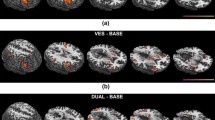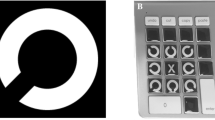Abstract
The experiments of Alessandro Volta were amongst the first to indicate that visuo-spatial function can be altered by stimulating the vestibular nerves with galvanic current. Until recently, the beneficial effects of the procedure were masked by the high levels of electrical current applied, which induced nystagmus-related gaze deviation and spatial disorientation. However, several neuropsychological studies have shown that much weaker, imperceptible currents that do not elicit unpleasant side-effects can help overcome visual loss after stroke. Here, we show that visual processing in neurologically healthy individuals can also benefit from galvanic vestibular stimulation. Participants first learnt the names of eight unfamiliar faces and then after a short delay, answered questions from memory about how pairs of these faces differed. Mean correct reaction times were significantly shorter when sub-sensory, noise-enhanced anodal stimulation was administered to the left mastoid, compared to when no stimulation was administered at all. This advantage occurred with no loss in response accuracy, and raises the possibility that the procedure may constitute a more general form of cognitive enhancement.

Similar content being viewed by others
Notes
We thank one of the reviewers for pointing out that right anodal stimulation might have been more effective had it been applied during the learning phase in which left hemisphere verbal-semantic processes would have been needed to link names to faces.
References
Bächtold D, Baumann T, Sándor P, Kritos M, Brugger P (2001) Spatial- and verbal-memory improvement by cold-water caloric stimulation in healthy subjects. Exp Brain Res 136:128–132
Balter S, Stokroos R, Eterman R, Paredis S, Orbons J, Kingman H (2004) Habituation to galvanic vestibular stimulation. Acta Otolaryngol 124:1–5
Barton J, Cherkesova M (2003) Face imagery and its relation to perception and covert recognition in prosopagnosia. Neurology 61:220–225
Bense S, Thomas S, Yousry T, Brandt T, Dieterich M (2001) Multisensory cortical signal increases and decreases during vestibular galvanic stimulation (fMRI). J Neurophysiol 85:886–899
Brandt T, Dieterich M (1999) The vestibular cortex: its locations, functions, and disorders. Ann N Y Acad Sci 871:293–312
Brandt T, Schautzer F, Hamilton D, Brüning R, Markowitsch H, Kalla R, Darlington C, Smith P, Strupp M (2005) Vestibular loss causes hippocampal atrophy and impaired spatial memory in humans. Brain 128:2732–2741
Briggs G, Nebes R (1975) Patterns of hand preference in a student population. Cortex 11:230–238
Broadbent N, Squire L, Clark R (2004) Spatial memory, recognition memory and the hippocampus. Proc Natl Acad Sci 101:14515–14520
Coats A (1972) The sinusoidal galvanic body-sway response. Acta Otolaryngol 74:155–162
Collins J, Imhoff T, Grigg P (1997) Noise-mediated enhancements and decrements in human tactile sensation. Phys Rev E 6:923–926
Collins J, Priplata A, Gravelle D, Niemi J, Harry J, Lipsitz L (2003) Noise-enhanced human sensorimotor function. IEEE Eng Med Biol Med 22:76–83
Dieterich M, Bense S, Lutz S, Drzezga A, Stephan T, Bartenstein P, Brandt T (2003) Dominance for vestibular cortical function in the non-dominant hemisphere. Cereb Cortex 13:994–1007
Fink G, Marshall J, Weiss P, Stephan T, Grefkes C, Shah N, Zilles K, Dieterich M (2003) Performing allocentric visuospatial judgments with induced distortion of the egocentric reference frame: an fMRI study with clinical implications. NeuroImage 20:1505–1517
Fitzpatrick R, Day B (2004) Probing the human vestibular system with galvanic vestibular stimulation. J Appl Physiol 96:2301–2316
Grimm R, Hemenway W, Lebray P, Black F (1989) The perilymph fistula syndrome defined in mild head trauma. Acta Otolaryngol 464:1–40
Hanes DA, McCollum G (2006) Cognitive–vestibular interactions: a review of patient difficulties and possible mechanisms. J Vestib Res 16:75–91
Laeng B, Rouw R (2001) Canonical views of faces and the cerebral hemispheres. Laterality 6(3):193–224
Lenggenhager B, Lopez C, Blanke O (2007) Influence of galvanic vestibular stimulation on egocentric and object based mental transformations. Exp Brain Res 184:211–221
Magnusson M, Pyykkö I, Jäntti V (1985) Effect of alertness and visual attention on optokinetic nystagmus in humans. Am J Otolaryngol 6:419–425
Moss F, Ward L, Sannita W (2004) Stochastic resonance and sensory information processing: a tutorial and review of applications. Clin Neurophysiol 115:267–281
Miller SM, Ngo TT (2007) Studies of caloric vestibular stimulation: implication for the cognitive neurosciences, the clinical neurosciences and neurophilosophy. Acta Neuropsychol 19:183–203
Nicolis C (1982) Stochastic aspects of climatic transitions: response to a periodic forcing. Tellus 34:1–9
Piana M, Canfora M, Riani M (2000) Role of noise in image processing by the human perceptive system. Phys Rev E 62:1104–1109
Rakover S (2002) Featural vs. configurational information in faces: a conceptual and empirical analysis. Br J Psychol 93:1–30
Riani M, Simonotto E (1994) Stochastic resonance in the perceptual interpretation of ambiguous figures: a neural network model. Phys Rev Lett 72:3120–3123
Rossion B, Schiltz C, Crommelinck M (2003) The functionally defined right occipital and fusiform “face areas” discriminate novel from visually familiar faces. Neuroimage 19:877–883
Rorsman I, Magnusson M, Johansson B (1999) Reduction of visuo-spatial neglect with vestibular galvanic stimulation. Scand J Rehabil Med 31:117–124
Saj A, Honore J, Rousseaux M (2006) Perception of the vertical in patients with right hemispheric lesion: effect of galvanic vestibular stimulation. Neuropsychologia 44:1509–1512
Tian J, Cane B, Demer J (2000) Vestibular catch-up saccades in labyrinthine deficiency. Exp Brain Res 131:448–457
Vallar G, Papagno C, Rusconi M, Bisiach E (1995) Vestibular stimulation, spatial hemineglect and dysphasia, selective effects. Cortex 31:589–593
Wada Y, Yamamoto T (2001) Selective impairment of facial recognition due to a haematoma restricted to the right fusiform and lateral occipital region. J Neurol Neurosurg Psychiatry 71:254–257
Watt D (1997) Pointing at memorized targets during prolonged microgravity. Aviat Space Environ Med 68:99–103
Wilkinson D, Donnelly N (1999) The role of stimulus factors in making categorical and coordinate spatial judgments. Brain Cogn 39:171–185
Wilkinson D, Ko P, Kilduff, McGlinchey R, Milberg W (2005) Improvement of a face perception deficit via subsensory galvanic vestibular stimulation. J Int Neuropsychol Soc 11:925–929
Yamamoto Y, Struzik Z, Soma R, Ohashi K, Kwak S (2005) Noisy vestibular stimulation improves autonomic and motor responsiveness in central neurodegenerative disorders. Ann Neurol 58:175–181
Zeng F, Fu Q, Morse R (2000) Human hearing enhanced by noise. Brain Res 869:251–255
Zheng Y, Darlington C, Smith P (2004) Bilaterlal labyrinthectomy causes longterm deficit in object recognition in rat. NeuroReport 15:1913–1916
Acknowledgments
We thank Jason Barton for providing the questions for the memory task, and Profs. Andrew Derrington and Howard Bowman for helpful comments on an earlier manuscript.
Author information
Authors and Affiliations
Corresponding author
Rights and permissions
About this article
Cite this article
Wilkinson, D., Nicholls, S., Pattenden, C. et al. Galvanic vestibular stimulation speeds visual memory recall. Exp Brain Res 189, 243–248 (2008). https://doi.org/10.1007/s00221-008-1463-0
Received:
Accepted:
Published:
Issue Date:
DOI: https://doi.org/10.1007/s00221-008-1463-0




